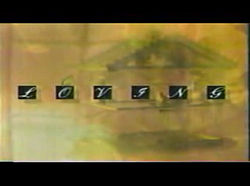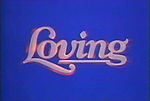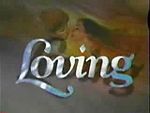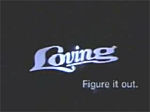- Loving (TV series)
-
Loving 
An image from the fourth opening title sequence of Loving (1992-1995).Genre Soap opera Created by Agnes Nixon
Douglas MarlandStarring (Original 1983 debut cast) Wesley Addy
Jennifer Ashe
Pamela Blair
Bryan Cranston
John Cunnigham
Peter Davies
Shannon Eubanks
Patricia Kalember
Teri Keane
James Kiberd
Tom Ligon
Christopher Marcantel
Perry Stephens
Lauren-Marie Taylor
Susan Walters
Ann WilliamsOpening theme "Theme from Loving" by Michael Karp (1983-1989); "The Loving Theme (#1)", sung by Johnny Mathis (1989-1991); "The Loving Theme (#2)", by David Randall Lowe and David M. Shapiro (1991-1992); "The Loving Theme (#3)", aka "L-O-V-I-N-G", by Jeffrey Osborne
(1992-1995)Composer(s) Michael Karp (multiple episodes)
Mike Renzi (multiple episodes, and series finale)
"Score Productions" (multiple episodes)Country of origin United States Language(s) English No. of episodes 3,169[1] Production Executive producer(s) See Crew Running time 30 minutes Broadcast Original channel ABC (U.S.)
Sky Soap (UK)Original run June 26, 1983 – November 10, 1995 Chronology Followed by The City Loving is an American television soap opera which aired on ABC's daytime lineup from June 26, 1983 to November 10, 1995 for 3,169 episodes.[2] The serial was co-created by Agnes Nixon and former actor Douglas Marland.
The show was broadcast in France under the title Amoureusement Votre (Lovingly Yours) and in Italy as Quando si ama (When someone loves).
Contents
History
With the established and successful ABC daytime soaps veering into a new trend of youth orientation and action/adventure storylines, a format heavy influenced by Gloria Monty on General Hospital, creators Agnes Nixon and Douglas Marland set out to develop a new series that would be introduced as a traditional, classic soap opera for the 1980s. Romance would be the show's key centerpiece; its original working title was Love Without End. By early 1983, the new creation was fully developed, as Loving, with a cast set for both a primetime premiere and a weekday run.
Loving premiered on June 26, 1983 as a two-hour primetime movie. It starred much of the original cast and featured film actors Lloyd Bridges and Geraldine Page. Set in the fictional town of Corinth, Pennsylvania, the early years of the show revolved around the blue-collar Donovans and the blue-blood Aldens. Major social issues such as incest, alcoholism, and post-traumatic stress syndrome of Vietnam vets were covered. But Marland and Nixon left the series after a few years and in spite of ABC's bumping down Ryan's Hope to give Loving a choice timeslot, and cast additions of such popular All My Children stars as Debbi Morgan and Jean LeClerc, the ratings remained poor throughout the show's run. Loving suffered from a constant revolving door of writers and producers, leading to questionable story moments such as a heroine's addiction to cough syrup and one character's selling his soul to the Devil. Circumstances became so desperate in the early 1990s that, to keep the show afloat, ABC assigned its own programming suits, network executive Haidee Granger and later, Vice President of Daytime Programming JoAnn Emmerich, to serve as Executive Producers. Nonetheless, on June 26, 1993, Loving celebrated its 10th Anniversary on ABC.
Long-running characters included Ava Rescott (played by Patty Lotz, 1983–1984; Roya Megnot, 1984–1988, 1990 as a temporary replacement; Lisa Peluso, 1988–1995), a schemer whose adventures ranged from stuffing a pillow in her dress to simulate pregnancy to being kidnapped at Universal Studios to being menaced by her lover's identical twin, Gilbert. Another longtime favorite was Stacey Donovan Forbes (portrayed by Lauren-Marie Taylor, the only continuously running original cast member), who was killed off via a poisoned powder puff in summer 1995, and Gwyneth Alden, the long-suffering matriarch who never stopped loving her roguish ex, Clay, or her mentally disturbed children, Trisha and Curtis.
In early 1995, ABC Daytime planned to cancel the show and asked new head writers James Harmon Brown and Barbara Esensten to find a way to salvage a few components of the series. The writers embarked upon the show's last big storyline, and what many considered one of the show's best storylines, the Corinth serial killer. Stacey, Clay, Curtis, Cabot, Isabelle, and Jeremy lost their lives, culminating in the revelation that an insane Gwyn had murdered most of her friends and family in a bid to "make their pain go away". Gwyn then injected herself with poison before the police could take her into custody. Loving characters Ally, Alex, Angie, Buck, Frankie, Jacob, Steffi, Jocelyn, and Tess moved to New York City's SoHo District and began a new series, The City, which would run until March 1997.
Ratings history
See also: List of US daytime soap opera ratingsAlthough Loving rated poorly throughout its history, its first few years were relatively encouraging. In its debut year it finished in 11th place and 3.9, above the then ailing soaps The Edge of Night and Search for Tomorrow. The following year it moved to a fairly comfortable 10th place and 4.1, holding that for the 1985-1986 television season with 4.2. A change in timeslot, with Loving occupying the slot previously held by Ryan's Hope, was a major factor in ratings improvement (albeit having the opposite effect on Ryan's Hope).
Unfortunately, the slow but steady ratings growth was not sustained. Loving fell back to 11th place, hitting last place for the first time in early 1989 (between the January series finale of Ryan's Hope and the March premiere of NBC's Generations), and then back to 11th. In January 1991, the series began ranking last again, and stayed there until its cancellation four years later.
When it originally premiered, the show aired at 11:30 AM ET/10:30 AM CT/MT/PT. On October 8, 1984, the show was moved to the later 12:30 PM/11:30 AM timeslot, bumping Ryan's Hope up to Noon/11:00. (This caused Ryan's Hope's ratings to plummet because many East Coast ABC stations pre-empted network programming at Noon for local news. Some affiliates, such as WSB-TV in Atlanta, chose to keep Ryan's Hope at 12:30.) Despite airing in the 12:30 timeslot, Loving never achieved the ratings Ryan's Hope had during its glory years. In the Central, Mountain and Pacific time zones, Loving was often pre-empted at 11:30 for local newscasts, airing on a one day delay earlier in the morning or not at all.
In 1992, after ABC stopped airing programming in the Noon/11:00 period, Loving was made available to affiliates at Noon/11 or 12:30/11:30. Some ABC stations outside of the Eastern Time Zone moved Loving to 11:00 AM to air local newscasts at 11:30. Despite the time slot changes on some affiliates, the national ratings for the show never improved.
Although the national ratings were never strong enough to climb above tenth place, Loving did beat the genre's top-rated program, CBS' The Young and the Restless in markets such as New York City, Los Angeles, Chicago, and Philadelphia, which were home to four of ABC's owned-and-operated stations; however, Loving only competed with the first half hour of The Young and the Restless.
Title sequences
During Loving's 12 year-run, the series went through quite a few theme and visual changes, primarily due to the ever-changing role of executive producer, and each's attempt to make the show more attractive to viewers (in order to boost ratings). In addition, Loving was one of the few soaps in history to implement a special, limited-run title sequence to represent a major storyline, for The Loving Murders in 1995. 
June 27, 1983 - March 24, 1989Nixon & Marland's Original Loving Image For its first six years on the air, Loving's main title visual consisted of a rather simple flash of the show's iconic script logo against a sky blue background. The outline of the title would appear in pink, entering diagonally, and then match itself with a white layer of the title; the two would zoom out together until the pink outline in the background disappeared, leaving the title in white. An underline below the Loving title was used in both title and closing sequences during this period. The design of the "L" in the show's logo is unique, in that if turned 90 degrees upward, it represents the shape of a heart. The instrumental theme, a pleasant 10-second waltz in D-major, was titled "Theme from Loving". The short sequence cut and the longer, complete version used in the closing sequence was written and composed by Michael Karp.
The closing credits sequence, which for the most part remained unchanged for Loving's first nine years on the air, used a live-action extended scene with a single character or more (minus dialogue), while the credits scrolled in white Goudy Bold Italic font. Since the soap was fully owned by Agnes Nixon's Dramatic Creations company, its copyright notice appeared much different than on its ABC-owned weekday stablemates: it was in the same Goudy font, on three different lines as "(year) Copyright, Dramatic Creations, Inc., All Rights Reserved", and showed up separately on the screen before the Loving logo. (In the 2-hour primetime pilot that aired on June 26, 1983, the copyright first appeared as "© 1983 Dramatic Creations, Inc., All Rights Reserved" on three separate lines, however.)
Originally, from the daytime premiere through 1985, all production principals, from creator through to associate producer, were centered on the screen, while cast lists and technical crew (which alternated) were positioned to the left. Joseph Stuart, Loving's inaugural executive producer, had used the left-hand-style credits on One Life to Live during the last three years of his tenure there (1980–1983). From Doug Marland's departure from the series in 1985 through the summer of 1988, the writers' credits became the only production principals to appear to the left of the screen.
For a brief few months in late 1987 into early 1988, the closing credit crawl appeared in transparent white, without the use of black shadowing. Soon after Joseph Hardy replaced Joseph Stuart in the spring of 1988, there were other minor cosmetic changes. The title sequence now featured a chime-like sound effect during the 4-6 second mark, as the pink outline of the show's title met the white display of it. The closing sequence also went from playing out mimed scenes to featuring a series of stills from that day's episode, a change made by Hardy five years earlier on Ryan's Hope, upon taking the helm of that series. The crawl, which now had its black shadowing reinstated, moved the writing staff back from the left side of the screen to the center.

March 27, 1989 - February 1, 1991The Johnny Mathis Loving Package Joseph Hardy changed Loving's musical scores and overall image to represent more of a youth appeal, steering away from the show's original old-fashioned, "classic" image. Nearly a year into his arrival, this shift included the show's theme song and visuals as well. On March 27, 1989, a new theme package debuted on Loving. The new theme was a full orchestral piece sung by Johnny Mathis, and was written by composers Bob Israel, Michel Camilo, and Bobby Daye.
The title sequence begins with a glass version of the iconic Loving logo moving gingerly toward the screen, at the bottom, over a replica of a religious painting of two boy and girl infant angels showing affection. This view proceeds into a series of charcoal and pastel paintings which chronicle one couple's romance throughout a single lifetime. The paintings overlapped each other while glass letters of the Loving logo flew over them (one at a time), and were the following:
- The preteen boy and girl sharing a first kiss
- The teenagers having a slow dance at their prom
- The two young adults engaging in passionate lovemaking
- The couple in a suit and veil on their wedding day
- Husband and wife holding their first child
- The couple embracing during older age (as evidenced by the man's white hair)
At the end of the sequence, the show's title in glass would zoom inward, with another layer meeting it in the back, over a variation of the original angel painting. The painting would then undergo a ripple effect, as if it were floating in wind or water.
Two longer-length versions of Johnny Mathis' theme were used in closings during this tenure, each running 2 minutes in full. The complete vocal version, performed by Mathis, was often used early on. When played, network announcements were not run over the credits. This alternated with a long instrumental cut on other episodes, featuring as much heavy orchestration as the opening and closing vocal tracks but with a trumpet solo playing along with the orchestration during the first several verses. Within a year and a half of this theme's debut, the instrumental track was used alone for the closing sequence. A variation in the lyrics of the opening and closing vocals occurred in the second line of the chorus; "My loving will..oh, touch you" in the opening was "My loving will protect you" in the full closing version.
The only graphic aspect to change in the closing on March 27, 1989 was that of the Loving logo, which had its underline removed. By July of that year, the copyright notice now appeared under the Loving logo at the end, still in the classical "(year) Copyright" format. Then, in December 1989, the notice was changed to the more conventional version of "© (year) Dramatic Creations, Inc. All Rights Reserved". It was now in a separate Helvetica Italic font. Also beginning that month, cast credits were divided into two different groups, principal cast followed by supporting players, with a large space between both groups. The cast credit division lasted through the end of Loving, and was used during the entire run of successor series The City. From December 1989 to April 1990 only, coordinating producer and executive producer credits, in that order, were moved towards the end of the credit crawl following "JOHNNY MATHIS Sings The Loving Theme" (which appeared after cast or crew everyday).
During the run of the Mathis theme/painting visuals, there would be an accelerated turnover in Loving staff, especially in the executive producer's chair. First, ABC moved Joseph Hardy over to General Hospital in late November 1989, replacing him with veteran daytime producer and future The Real World creator/producer Mary-Ellis Bunim. Bunim, however, only served four months as the show's EP before abruptly leaving. In April 1990, former All My Children producer Jacqueline Babbin took over. Although she agreed to only stay on for a year, Babbin decided to make some noticeable adjustments of her own, which eventually included the Loving theme package. After just less than two years, the Mathis theme was retired on February 1, 1991.

February 4, 1991 - February 13, 1992New Age Loving - The Contender For the Shortest Lived Soap Opening Ever On February 4, 1991, new opening visuals premiered, composed of a series of videotaped, live-action shots of a couple's romance. These shots include a man feeding a strawberry into a woman's mouth, a shattering wine glass, the man placing a ring on the woman's finger, etc. Every scene is taped with dark-colored backdrops, each with a different color, and only the portions of the man and woman's faces and hands are revealed. Some scenes transition with freeze-framed shots of the action(s) in a small square graphic, which fades out as the next shot begins. The last scene is a silhouette of the man and woman holding hands, and then embracing, over a sunset sky visual, while the Loving logo flashes to the center of the screen, with the font clear and transparent. The woman who is partially seen throughout the opening is model Jane Ericson.
The dramatic, yet somewhat soothing theme music, which featured piano and synthesizers, was composed by David Randall Lowe and David M. Shapiro. The cut of Lowe/Shapiro Loving theme used in the title sequence was 25 seconds long, and was accented by loud sound effects used to emphasize the actions taking place (i.e., the sound of shattering when the wine glass breaks, etc.). The longer closing version featured modified instrumentation and no sound effects. However, unlike the extended theme music of other programs, the closing track did not expand upon the opening melody; rather, it repeated the same 25 seconds of notes twice during the song, with an original one-note bridge serving between each loop, before repeating the last 10 seconds of the melody to add diversity. The longest airings of the Lowe/Shapiro closing had at least four of the 25-second sections separated in the middle by one 10-second portion.
The graphic changes that occurred in the closing credits during the previous theme package, along with the long-running Goudy Bold setup, remained in place for another year. The visuals overall, and the new age theme song that accompanied it, were later seen as a preview of the similar "New Age" visuals of One Life to Live, which ran from January 1992 to November 1995. While this Loving theme package was still running when OLTL's new package debuted, it would be gone a month later—due to the fact that executive producer Fran Sears, who had replaced Jacqueline Babbin in July 1991, wanted to implement different visuals of her own.

February 14, 1992 - November 10, 1995The Final Main Package ft. Jeffrey Osborne Appropriately enough, for Valentine's Day on February 14, 1992, the final Loving main title visuals and theme debuted. It was clear that Fran Sears wanted to bring back a vocal theme, but she did so this time with a younger popular artist, R&B star Jeffrey Osborne. The new theme by Osborne was joined by new visuals that panned over the inside of the master bedroom of two lovers, which was followed by overlapping squares and shots of rose pedals. The entire sequence was tinted in shades of red and pink. The final scene displayed a shot of a birdcage sitting by the bedroom's window (which was seen within the first few seconds of the sequence, as the camera pan began), while a brand new Loving logo appeared over it; the logo consisted of each letter of the title, in white capital script, encased in individual black boxes. Once the title is firm on the screen, the birds in the cage become more visible, and a yellow canary appears to be sitting on the black box containing the letter "O" in the new Loving logo.
Originally, an all-new, innovative closing credits format accompanied these visuals. Scenes that were based on, and directly from the title sequence were seen on the left side of the screen while the credits, in a new, smaller Times New Roman white font, appeared against a black square potion of the screen on the right. Most often the credits now faded in and out, but at times they would even scroll. Joining the closing visuals was a full instrumental version of Jeffrey Osborne's Loving theme, with minor vocal contingents being heard in the end of it. Possibly due to an unfavorable reaction from viewers, this credits sequence was scrapped after only a month.
Thereafter, beauty shots (mimed scenes) of the characters were reinstated for the closing, for the first time since 1988. The credit font remained in Times New Roman from the February revamp, and the closing version of the new Osborne theme continued. A return to beauty shots also meant the reinstatement of the original Loving logo, that was now no longer used in the title sequence. From March 1992 through fall 1993, it appeared diagonally on either the left or right bottom corner of the screen (often alternating), across a small pink heart. Under this artistic display, the copyright appeared in thin, mostly lowercase Times New Roman, and was just as small as the logo. Prior to this display at the end of all closing sequences, the "Videotaped at ABC Television Center in New York" credit would scroll up, remain still, and then fade out. During this period, there was no Loving logo before the credit crawl. By the fall of 1993, a more traditional display of the classic Loving logo returned to closings, with the title appearing dead center of the screen as the sequence opened. As the sequence ended, the copyright remained the same, and was as large as the current size of title logo.
While the title sequence remained the same, and the package itself managed to outlast the previous two, the minor closing credit changes aforementioned were just small indications of the revolving door of executive producers, which continued its swing during the final three-and-a-half years. Only three months into the Osborne package, Fran Sears was out, replaced by Haidee Granger. Seen by viewers as Loving officially going on "life support" due to Granger's role at ABC (she was a recently-arrived network executive), Granger had one of the hardest turns as show-runner on the program. She would be ousted by two more replacements, first with JoAnn (Josie) Emmerich in November 1993, and finally with Jean Dadario Burke in December 1994. Fortunately, none of them chose to change this theme package in any way.
With the exception of the period from July to October of 1995, in which The Loving Murders story arc ran, the Jeffrey Osborne theme package ran until Loving's final telecast on November 10, 1995.

July 1995 - October 1995The Loving Murders Special Sequence After ABC announced that Loving would be folded into the new soap The City, the producers planned to kill off many of the show's central and veteran characters, while the survivors would ultimately be carried over to The City. In July 1995, The Loving Murders plot began, in which a mysterious character killed each selected citizen of Corinth in a unique way. For the duration of the storyline, a special sequence was used which encouraged viewers to "figure it out". It consisted of black-and-white or dark color shots of various objects ticking - from a pen, to a metronome, clock, a purse, etc. During the series of objects, a woman narrated the official epigram to the plotline:
"This is the sound of trouble. The kind that caresses lives, even as it steals them away. That delicately unravels the fabric of entire towns like Corinth, Pennsylvania. When the trouble comes, it will sound like this. (clicking sound) And Loving, will never be the same again. Trouble, with a capital L. Figure it out."
At the end of the sequence, there are the letters L-O-V-I-N-G cut out from magazines, ala a ransom note. Arranged on a table or some sort of light-colored surface, the letters are promptly blown away. The final scene has the original Loving logo (the one used in opening sequences from 1983-1992, but still in the closing to the very end) floating around like it is on a curtain that is blowing, with "Figure it out" on the bottom right corner.
Notably, during key scenes of the storyline in which every murder or clue was executed, the "Figure it out" tagline would appear in either bottom corner of the screen for a brief few moments. It appeared in a clear-colored, grunge variation of Courier font. The instrumental Jeffrey Osborne closing theme remained in use during The Loving Murders time frame.
Cast and crew
Cast
Main article: List of Loving cast and charactersExecutive Producers
Duration Name June 27, 1983 to June 17, 1988 Joseph Stuart June 20, 1988 to November 30, 1989 Joseph Hardy December 3, 1989 to April 1990 Mary-Ellis Bunim April 1990 to July 12, 1991 Jacqueline Babbin July 15, 1991 to May 25, 1992 Fran Sears May 26, 1992 to October 1993 Haidee Granger November 11, 1993 to December 1994 JoAnn Emmerich December 1994 to November 10, 1995 Jean Dadario Burke Producers
Duration Name 1990 to 1992 Barbara Duggan 1992 to December 1994 Jean Dadario Burke December 1994 to November 10, 1995 Jane Elliot & Laura Rakowitz Associate Producers
Duration Name June 27, 1983 to September 1988 Barbara Duggan September 1988 to January 1990 Achille Raspantini January 1990 to January 1992 Richard Schilling January 1992 to 1994 Heidi Adam 1994 Heidi Adam & Dana Walker Keane December 1994 to May 1995 Heidi Adam May 1995 to November 10, 1995 None Coordinating Producers
Duration Name September 1988 to 1990 Barbara Duggan 1990 to May 1995 None May 1995 to November 10, 1995 Heidi Adam Head Writers
Years Names 1983–1985 Douglas Marland 1985–1987 Agnes Nixon 1987–1988 Ralph Ellis 1988–1991 Millee Taggert
Tom King1991 Mary Ryan Munisteri 1991–1992 Addie Walsh 1992–1993 Millee Taggert
Robert Guza, Jr.1993 Millee Taggert 1994 Addie Walsh
Laurie McCarthy[citation needed]1994 Agnes Nixon 1994–1995 Barbara Esensten
James Harmon BrownReferences
- ^ "Loving at TV.com", ABC. URL last accessed 2008-06-17.
- ^ "Loving at TV.com", ABC. URL last accessed 2008-06-17
External links
Categories:- 1983 television series debuts
- 1995 American television series endings
- 1980s American television series
- 1990s American television series
- American television soap operas
- American Broadcasting Company network shows
- Television series by Buena Vista Television
Wikimedia Foundation. 2010.
